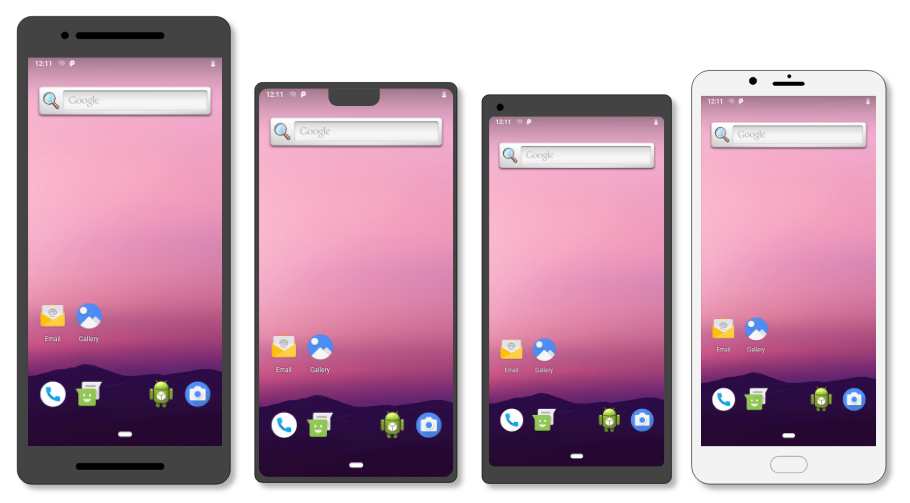صورة النظام العامة (GSI) هي تنفيذ لنظام Android الأساسي يتضمّن رمزًا برمجيًا غير معدَّل من "مشروع Android المفتوح المصدر" (AOSP)، ويمكن تشغيله على مجموعة متنوعة من أجهزة Android.
يمكن لمطوّري التطبيقات تثبيت أحدث حِزم GSI لنظام Android وتشغيلها لإجراء اختبارات التطبيقات على مجموعة متنوعة من أجهزة Android الحالية وباستخدام حِزم GSI من مراحل إصدار مختلفة لنظام التشغيل Android، بما في ذلك إصدارات "المعاينة للمطوّرين" وإصدارات "الإصدار التجريبي". يمكن أن توفّر لك إضافة حزم GSI إلى عمليات التحقّق والاختبار بعض المزايا الإضافية:
- تغطية أوسع للاختبار على مجموعة أكبر من الأجهزة الحقيقية
- المزيد من الوقت لحلّ مشاكل توافق التطبيقات
- المزيد من الفرص لحلّ مشاكل التوافق في Android التي أبلغ عنها مطوّرو التطبيقات
مشروع صور نظام التشغيل العام (GSI) هو مشروع مفتوح المصدر ويساعد في تحسين منظومة Android المتكاملة من خلال توفير المزيد من الطرق لتحسين جودة التطبيقات ونظام التشغيل قبل كل إصدار من إصدارات Android.

تتضمّن صور نظام التشغيل العامة وظائف النظام الأساسية نفسها لجميع الأجهزة التي يتم تثبيتها عليها. بعبارة أخرى، لا يتضمّن GSI التعديلات التي تجريها الشركة المصنّعة للجهاز. نتيجةً لذلك، قد تواجه اختلافات في السلوك في الحالات التالية:
- التفاعلات التي تتضمّن واجهة المستخدم
- سير العمل الذي يتطلّب ميزات أجهزة أحدث
التحقّق من امتثال الجهاز
لا يمكن أن تعمل حزم GSI إلا على الأجهزة التي تتضمّن الخصائص التالية:
- برنامج الإقلاع غير مقفل.
- متوافق تمامًا مع Treble
- تم إطلاقه بنظام التشغيل Android 9 (المستوى 28 لواجهة برمجة التطبيقات) أو إصدار أحدث. قد تكون الأجهزة التي تمت ترقيتها إلى Android 9 من إصدار أقدم متوافقة مع صور نظام التشغيل العامة (GSI) أو غير متوافقة معها.
لتحديد ما إذا كان جهازك يمكنه استخدام صورة نظام عامة (GSI) وإصدار نظام التشغيل الذي يجب تثبيته، اتّبِع الخطوات التالية:
تحقَّق من توفّر توافق Treble من خلال تنفيذ الأمر التالي:
adb shell getprop ro.treble.enabled
إذا كانت الاستجابة
false، يعني ذلك أنّ الجهاز غير متوافق مع حِزم GSI ولا يجب المتابعة. إذا كانت الاستجابةtrue، انتقِل إلى الخطوة التالية.تحقَّق من التوافق بين الإصدارات المختلفة من خلال تنفيذ الأمر التالي:
adb shell cat /system/etc/ld.config.version_identifier.txt \ | grep -A 20 "\[vendor\]"
في الناتج، ابحث في القسم
[vendor]عنnamespace.default.isolated.إذا كانت قيمة هذه السمة هي
true، يعني ذلك أنّ الجهاز يتوافق تمامًا مع حزمة تطوير البرامج الأصلية الخاصة بالمورّد (VNDK) ويمكنه استخدام أي إصدار من نظام التشغيل (OS) الخاص بصورة النظام العامة (GSI) أحدث من إصدار نظام التشغيل على الجهاز. استخدِم أحدث إصدار متاح من نظام التشغيل GSI كلما أمكن ذلك.إذا كانت قيمة السمة هي
false، يعني ذلك أنّ الجهاز غير متوافق تمامًا مع VNDK، ولا يمكنه استخدام سوى صورة نظام عام (GSI) لإصدار نظام التشغيل نفسه على الجهاز. على سبيل المثال، لا يمكن لجهاز يعمل بالإصدار 10 من نظام التشغيل Android (المستوى 29 من واجهة برمجة التطبيقات) وغير متوافق مع VNDK تحميل سوى صورة GSI للإصدار 10 من نظام التشغيل Android.يجب أن يتطابق نوع بنية وحدة المعالجة المركزية (CPU) لصورة نظام GSI مع بنية وحدة المعالجة المركزية للجهاز. للعثور على بنية وحدة المعالجة المركزية المناسبة لصورة GSI، نفِّذ الأمر التالي:
adb shell getprop ro.product.cpu.abi
استخدِم الناتج لتحديد صورة GSI التي يجب استخدامها عند نقل البيانات إلى جهازك. على سبيل المثال، على هاتف Pixel 5، ستشير النتيجة إلى أنّ بنية وحدة المعالجة المركزية هي
arm64-v8a، لذا عليك استخدام نوعarm64من حزمة GSI.
تنزيل صور نظام عامة (GSI)
تتوفّر عدة طرق للحصول على معرّفات GSI، وذلك حسب احتياجاتك المتعلقة بالتطوير:
- لتنزيل صور GSI للإصدار التجريبي من Android وصور GSI لنظام Android مع "خدمات Google للأجهزة الجوّالة"، انتقِل إلى صفحة إصدار GSI.
لتنزيل صور GSI المُنشأة مسبقًا بدون تطبيقات GMS، يمكنك تنزيل الصور من موقع AOSP CI:
لإنشاء حِزم GSI لنظام Android بدون GMS، نزِّل الرمز المصدري من مشروع Android المفتوح المصدر (AOSP) وأنشئ حِزم GSI.
تثبيت صورة نظام عامة (GSI)
يعتمد تثبيت صورة نظام عامة (GSI) على الجهاز. يُرجى الرجوع إلى الشركة المصنّعة لجهازك لمعرفة الأدوات والإجراءات الدقيقة. بالنسبة إلى أجهزة Google Pixel، مثل Pixel 3 والإصدارات الأحدث، تتوفّر عدة طرق للتثبيت:
- تثبيت صور GSI يدويًا: يُرجى الاطّلاع على متطلبات تثبيت GSI
- استخدام ميزة "تحديث النظام الديناميكي" (DSU) للأجهزة التي تعمل بالإصدار 10 من نظام التشغيل Android أو الإصدارات الأحدث: يُرجى الاطّلاع على صفحة تحديثات النظام الديناميكي
تقديم ملاحظات
تهدف صور نظام التشغيل العام إلى مساعدتك في التحقّق من صحة تطبيقاتك على Android. نقدّر ملاحظاتك حول الصور والأدوات وعملية استخدام صور نظام التشغيل العامة على أجهزتك.
لإعلامنا بالأخطاء أو طلبات الميزات، استخدِم مكوّن أداة تتبُّع المشاكل المخصّص لحزم GSI.

